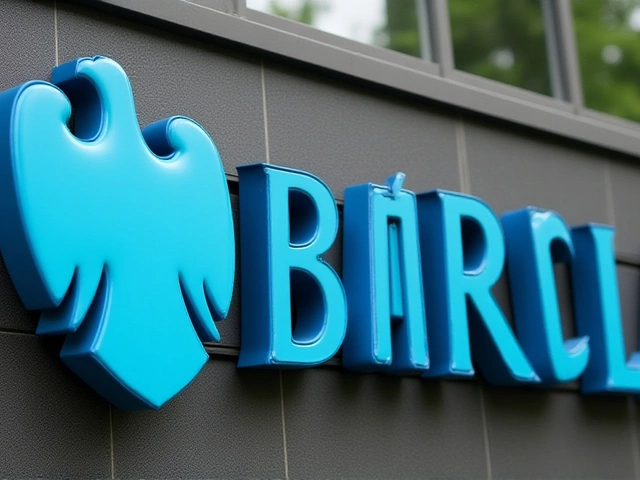When Barclays PLC opened its Q3 2025 results at 7:00 AM GMT on October 17, the market reacted like a crowd at a rock concert – cheers, applause, and a rapid surge. The London‑listed bank’s shares vaulted 7.2% to 342.60 pence, nudging the FTSE 100 up 1.7% as investors cheered a pre‑tax profit of £2.87 billion, a full 12.3% over consensus. Right after the numbers dropped, Barclays announced a £2.5 billion share‑repurchase plan that will run from October 28 through December 15, earmarking roughly 4.7% of its floating stock. The combo of earnings smash and aggressive capital return sent the share price skimming the highest level seen since January 2015.
Q3 Earnings Beat the Forecast
The bank’s three‑month earnings package was anchored by a 22.7% jump in investment‑banking revenue to £3.21 billion and a 15.3% lift in consumer‑banking profit to £1.89 billion. Analysts had penciled in a pre‑tax profit of £2.56 billion, so the £2.87 billion figure represented a comfortable cushion. Bailey Pemberton, a senior analyst at Simply Wall Street, highlighted the result in a note dated October 15, saying, “Barclays delivered a 62.1% total return over the last year and now scores a strong 5 out of 6 on our valuation checks.” The comment underscored that, despite the rally, the stock still looked fairly priced relative to its earnings trajectory.
£2.5 Billion Share Repurchase Program
Barclays’ buyback announcement read like a reminder that the bank has plenty of capital to hand back to shareholders. The programme, set to start on October 28 and finish by December 15, will be funded out of the bank’s robust CET1 ratio of 14.8% as of September 30, well above the regulator’s 11.5% floor. The £2.5 billion sum represents roughly 4.7% of the bank’s total shares outstanding, a scale not seen since the 2018‑19 capital‑return wave.
Institutional investors cheered the news immediately. The London Stock Exchange reported that buy‑side algorithmic orders accounted for about 38% of the total trading volume during the surge, according to Meyka Financial Analytics. Such mechanical buying amplified the price move, turning a solid earnings beat into a full‑blown rally.
Market Reaction and Analyst Views
Beyond Barclays, the day highlighted a broader optimism in UK banks. Jason Goldberg, a senior financial‑services analyst at Barclays Capital Securities Limited, lifted his price target for Bank of New York Mellon (NYSE:BK) from $104 to $120 – a 15.4% hike – reinforcing the notion that capital‑return moves are being interpreted as confidence signals across the sector.
Meanwhile, the bank reaffirmed an “Overweight” stance on SSE PLC on October 16, with an average one‑year target of $28.17, implying an 18.3% upside. The backing came from a growing institutional ownership base: 429 funds held SSE shares, up 19 owners (4.63%) from the prior quarter.
When you tally the sentiment, the numbers speak loudly: 28 of 35 major broker houses covering Barclays retained “Buy” or equivalent ratings, and the consensus 12‑month price target sits at 385.40 pence – a 12.5% premium to the closing price on the day of the rally.
However, not everyone is unconditionally bullish. The Motley Fool UK warned that some peers could post earnings‑per‑share growth that more than doubles by next year, driving forward P/E ratios down to 7.6 – a figure that looks cheap compared with Barclays’ current multiple.
Broader Banking Landscape
The backdrop to Barclays’ performance is a dramatically higher interest‑rate environment. The Bank of England’s base rate sat at 5.75% on October 17, up from a historic low of 0.10% in October 2020. That swing has inflated net‑interest margins for traditional lenders, providing a tailwind that helped lift Barclays’ earnings.
Regulatory capital remains comfortably above the floor, and the bank’s balance‑sheet strength gives it flexibility to pursue further dividend hikes or additional buybacks later in the year. The FTSE 100’s 1.7% rise on the day also suggests that investors see British banks as a relatively safe harbor amid lingering global uncertainty.
Looking Ahead: What’s Next for Barclays?
Analysts are already scanning the pipeline for the next catalyst. The bank’s Q4 guidance, due at the end of January 2026, will likely reflect whether the current rate‑driven profit surge can be sustained as the central bank hints at a pause or modest cut to rates later in the year.
In parallel, the ongoing digital‑banking transformation continues to eat into traditional margins. Barclays has pledged £1.2 billion for technology upgrades over the next three years, a spend that could pressure short‑term profitability but is expected to pay dividends in customer‑experience scores.
Finally, the upcoming Annual General Meeting on March 4, 2026 will put the shareholder buyback under the microscope, as investors will assess whether the program delivers the anticipated earnings‑per‑share uplift.
- Q3 2025 pre‑tax profit: £2.87 billion (vs. £2.56 billion estimate)
- Share price jump: 7.2% to 342.60 pence
- Buyback size: £2.5 billion, covering ~4.7% of shares
- Year‑to‑date gain: 39.8%
- Five‑year performance: +332.4%
Frequently Asked Questions
How does the £2.5 billion buyback affect ordinary shareholders?
The repurchase reduces the total number of shares outstanding, which mechanically lifts earnings‑per‑share and often nudges the share price higher. For investors holding Barclays stock, the buyback translates into a modest, tax‑efficient return of capital that complements any dividend they receive.
What role did the Bank of England’s interest‑rate policy play in the earnings beat?
Higher base rates widen the net‑interest margin for lenders, meaning Barclays earns more on the gap between what it pays on deposits and what it charges on loans. The 5.75% rate in October 2025, up from 0.10% in 2020, gave the bank a sizable profit boost that fed directly into the Q3 numbers.
Why are some analysts cautioning about future earnings growth compared to peers?
Competitors are forecasting EPS that could more than double next year, which would compress forward P/E ratios to around 7.6. If those projections materialize, Barclays may look relatively expensive despite its strong current performance, prompting a re‑evaluation of its valuation.
What are the expectations for Barclays’ dividend policy after the buyback?
The bank’s solid CET1 ratio leaves room for a modest dividend increase in 2026, though the primary focus appears to be on the share‑return program this year. Investors can expect the dividend to stay steady, with any upside likely dependent on the outcome of the Q4 results and the broader rate environment.
When will the next major update on Barclays’ financial outlook be released?
Barclays is scheduled to publish its full‑year 2025 results and Q4 guidance at the end of January 2026. The Annual General Meeting on March 4, 2026 will also provide a platform for shareholders to discuss the buyback’s impact and any future capital‑return plans.





